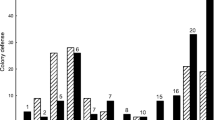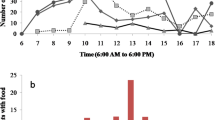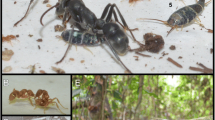Abstract
Spatial organization was estimated in mixed-species groups of ants with interindividual distance measures as a function of: (1) the age of the workers when associated; and (2) the presence of the brood. Workers ofManica rubida (Myrmicinae) andFormica selysi (Formicinae) were reared in single-species groups (control) or in artificial, mixed-species groups, created 5 h, 12 h or 22 h after emergence, with or without brood. By recording the location of each individual in the nest during the 10 days following the creation of the groups, we evaluated the spatial organization and the interindividual distances between homocolonial or allospecific workers, and between workers and homocolonial or allospecific brood. The cohesion of the group, depend on the age of the workers when associated: the younger the individuals are when the groups are created, the smaller are the interindividual distances. Moreover, homocolonial individuals aggregated with brood, when present, which improves the overall cohesion of the group. However, in mixed groups, both species associated preferentially with members of their own species. This suggests that newly-emerged ants do not depend totally on the odors of their nestmates to construct their recognition template and that they also possess an innate, specific template.
Similar content being viewed by others
References
Ayre, G.L. & M.S. Blum 1971 Attraction and alarm of ants (Camponotus spp.-Hymenoptera: Formicidae) by pheromones.Physiol. Zool. 44: 77–83.
Bagnères, A.G., C. Errard, C. Mulheim, C. Joulie & C. Lange 1991 Induced mimicry of colony odors in ants.J. Chem. Ecol. 17: 1641–1664.
Berton, F., Lenoir, A., Nowbahari, E. & S. Barreau 1991 Ontogeny of queen attraction to workers in the antCataglyphis cursor (Hymenoptera: Formicidae)Ins. Soc. 38: 293–305.
Blum, M.S. 1987 The basis and evolutionary significance of recognitive olfactory acuity in insect societies. In: L.M. Pasteels & J. L. Deneubourg (eds.)From individual to collective behavior in social insects. pp. 277–293. Birkhauser Verlag, Basel.
Bonavita-Cougourdan, A., J.L. Clément & C. Lange 1987 Nestmate recognition: The role of cuticular hydrocarbons in the antCamponotus vagus Scop.J. Entomol. Sc. 22: 1–10.
Breed, M.D. & B. Bennett 1987 Kin recognition in hightly eusocial insects. In: D.J.C. Fletcher & C.D. Michener (eds.)Kin recognition in animals. pp. 243–285. John Wiley, New York.
Bushinger, A., W. Ehrhardt, & U. Winter 1980 The organization of slave raids in dulotic ants-a comparative study (Hymenoptera: Formicidae).Z. Tierpsychol. 53: 245–264.
Carlin, N.F. & B. Hölldobler 1986 The kin recognition system of carpenter ants (Camponotus spp.), I: Hierarchical cues in small colonies.Behav. Ecol. Sociobiol. 19: 123–134.
Clément, J.L., A. Bonavita-Cougourda & C. Lange 1987 Nestmate recognition and cuticular hydrocarbons inCamponotus vagus Scop. In: J. Eder & H. Rembold (eds.)Chemistry and Biology of Social Insects. pp. 473–474. Verlag J. Peperny, Munich.
Corbara, B. & C. Errard 1991 The organization of artifical heterospecific ant colonies. The case of theManica rubida/Formica selysi association: mixed colony or parallel colonies?Behav. Proc. 23: 75–87.
Errard, C. 1984 Evolution, en fonction de I'âge, des relations sociales dans les colonies mixtes hétérospécifiques chez les fourmis des genresCamponotus etPseudomyrmex.Ins. Soc. 31: 185–198.
Errard, C. & P. Jaisson 1984 Etude des relations sociales dans les colonies mixtes hétérospécifiques chez les fourmis (Hymenoptera, Formicidae).Folia Entomol. Mex. 61: 135–146.
Errard, C. 1994a Development of interspecific recognition behavior in the antsManica rubida andFormica selysi (Hymenoptera: Formicidae) reared in mixed species groups.J. Ins. Behav. 7: 83–99.
Errard, C. 1994b Long-term memory involved in nestmate-recognition in ants.Anim. Behav. 48: 263–271.
Errard, C. & J.M. Jallon 1987 An investigation of the development of the chemical factors in ants intra-society recognition. In: J. Eder & H. Remblod (eds.)Chemistry and Biology of Social Insects. p. 478. Verlag J. Peperny, Munich.
Errard, C. & P. Jaisson 1991 Les premières étapes de la reconnaissance interspécifique chez les fourmisManica rubida et Formica selysi (Hymenoptera, Formicidae) élevées en colonies mixtes.C.R. Acad. Sci. Paris 313: 73–80.
Fresneau, D., B. Corbara & J.P. Lachaud 1989 Organisation sociale et structuration spatiale autour du couvain chezPachycondyla apicalis (Formicidae, Ponerinae).Actes Coll. ins. Soc. 5: 83–92.
Gadagkar, R. 1985 Kin recognition social insects and other animals-A review of recent findings and a consideration of their relevance for the theory of kin selection.Proc. Indian. Acad. Sci. 94: 587–621.
Hantgartner, W. 1969 Carbon dioxide, a releaser for digging behavior inSolenopsis geminata (Hymenoptera: Formicidae).Zeit. Very. Physiol. 62: 111–120.
Hölldobler, B. 1977 Communication in social Hymenoptera. In: T.A. Sebeok (ed.)How animals communicate. pp. 418–471. Indiana University Press, Bloomington.
Hölldobler, B. & C.D. Michener 1980 Mechanisms of identification and discrimination in social Hymenoptera. In: H. Markl (ed.)Evolution of social behavior: hypotheses and empirical tests. pp. 35–58. Verlag Chemie, Weinheim.
Hölldobler, B. & E.O. Wilson 1977 Colonyspecific territorial pheromone in the African weaver antOecophylla longinoda (Latreille).Proc. Nat. Acad. Sc. USA 74: 2072–2075.
Hölldobler, B. & E.O. Wilson 1990 The ants. The Belknap Press of Harvard University Press, Cambridge, Massachusetts.
Howard, R.W., McDaniel, C.A. & G.J. Blomquist 1980 Chemical mimicry as an integrating mechanism: Cuticular hydrocarbons of a termitophile and its host.Science 210: 431–433.
Howse, P.E. 1975 Chemical defenses in ants, termites and other insects. Some outstanding questions. In: C. Noirot, P.E. Howse & G. Le Masne (eds.)Pheromones and defensive secretions social insects. pp. 23–40. Dijon.
Isingrini, M., Lenoir & P. Jaisson 1985 Preimaginal learning as a basis of colony-brood recognition in the antCataglyphis cursor.Proc. Natl. Acad. Sci. USA 82: 8545–8547.
Jaisson, P. 1972 Nouvelles expériences sur l'agressivité chez les fourmis; existence probable d'une substance active inhibitrice de l'agressivité et secrétée par la jeune formicine.C. R. Acad. Sci. Paris 274: 429–432.
Jaisson, P. 1975 L'imprégnation dans l'ontogénése des comportements de soins aux cocons chez la jeune fourmi rousse (Formica polyctena Först).Behaviour 52: 1–37.
Jaisson, P. 1980 Les colonies mixtes plurispécifiques: un modèle pour l'étude des fourmis.Biol. Ecol. Mediter. 3: 163–166.
Jaisson, P. 1991 Kinship and fellowship in ants and social wasps. In: P.G. Hepper (eds.)Kin recognition. pp. 60–93. University Press, Cambridge.
Jaisson, P., F., Nicolosi, R.W. Taylor, D. Fresneau & A. Lenoir 1991 Distance to the nearest neighbour and workers specialization along the evolution of primitive ants.Proc. JSPS. CNRS Seminar, Primate Institute, Inuyama Japan, pp. 5–7.
Le Moli, F. & A. Mori. 1985 The influence of the early experience of worker ant on enslavement.Anim. Behav. 33: 1384–1387.
Lenoir, A., M. Isingrini & E. Nowbahari 1987 Colony recognition in the antCataglyphis cursor (Hymenoptera, Formicidae). In: J. Eder & H. Rembold (eds.)Chemistry and biology of social insects. p. 260. Verlag J. Peperny, Munich.
Morel, L & R.K. Vander Meer 1987 Nestmate recognition inCamponotus floridanus: behavioral and chemical evidence for the role of age and social experiece. In: J. Eder & H. Rembold (eds.)Chemistry and biology of social insect. p. 471. Verlag J. Pepermy, Munich.
Morel, L. & R.K. Vander Meer 1988 Do ant brood pheromones exist?Ann. Entomol. Soc. Amer. 81: 705–710.
Morel, L., R.K. Vander Meer & B.K. Lavine 1988 Ontogeny of nestmate recognition cues in the red carpenter ant (Camponotus floridanus): behavioral and chemical evidence for the role of age and social experience.Behav. Ecol. Sociobiol. 22: 175–183.
Nowbahari, E. & A. Lenoir 1989 Age related changes in aggression in antCataglyphis cursor (Hymenoptera, Formicidae): influence on intracolonial relationships.Behav. Proc. 18: 173–181.
Snyder, L.E. 1993 Non-random behavioural interactions among genetic subgroups in a polygynous ant.Anim. Behav. 46: 431–439.
Stuart, R.J. 1992 Nestmate recognition and the ontogeny of acceptability in the ant,Leptothorax curvispinosus.Behav. Ecol. Sociobiol. 30: 403–408.
Vander Meer, R.K. & D.P. Wojcik 1982 Chemical mimicry in the myrmecophilous beetleMyrmecaphodius excavaticollis.Science 2: 806–808.
Wilson, E.O. 1962 Chemical communication among workers of the fire antSolenopsis seavissima (Fr. Smith), 1: The organization of mass-foraging, 2: An information analysis of the odour trail, 3: The experimental induction of social responses.Anim. Behav. 10: 134–147. 148–158, 159–164.
Wilson, E.O. 1971 The Insect Societies. The Belknap Press of Harvard University Press, Cambridge, Massachusetts.
Wilson, E.O. 1975 Sociobiology: the new synthesis. The Belknap Press of Harvard University Press, Cambridge, Massachusetts.
Author information
Authors and Affiliations
About this article
Cite this article
Errard, C., Lenoir, A. Interindividual distances in mixed-species groups of ants: an estimation of cohesion in social groups. J. Ethol. 13, 85–94 (1995). https://doi.org/10.1007/BF02352567
Received:
Accepted:
Issue Date:
DOI: https://doi.org/10.1007/BF02352567




